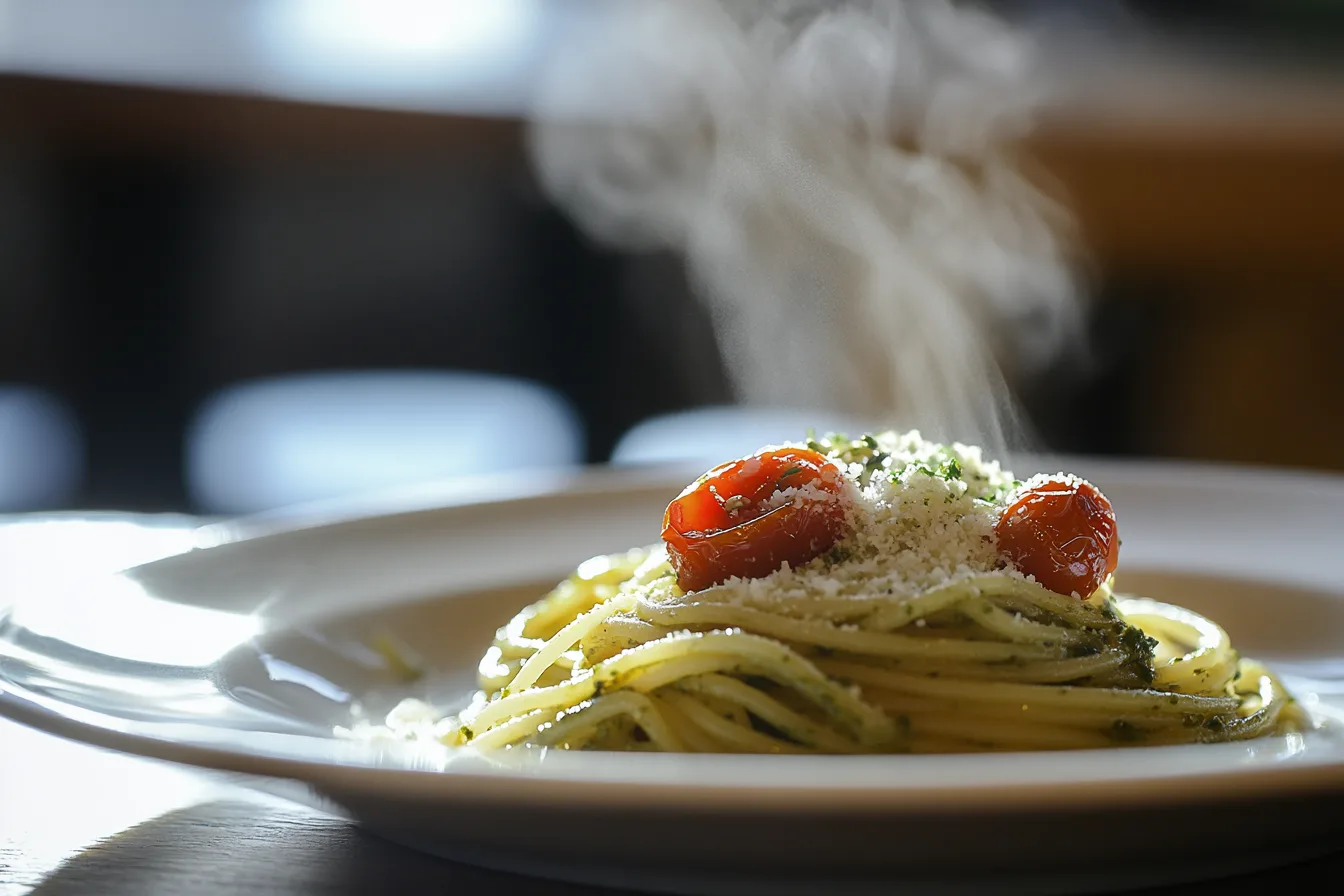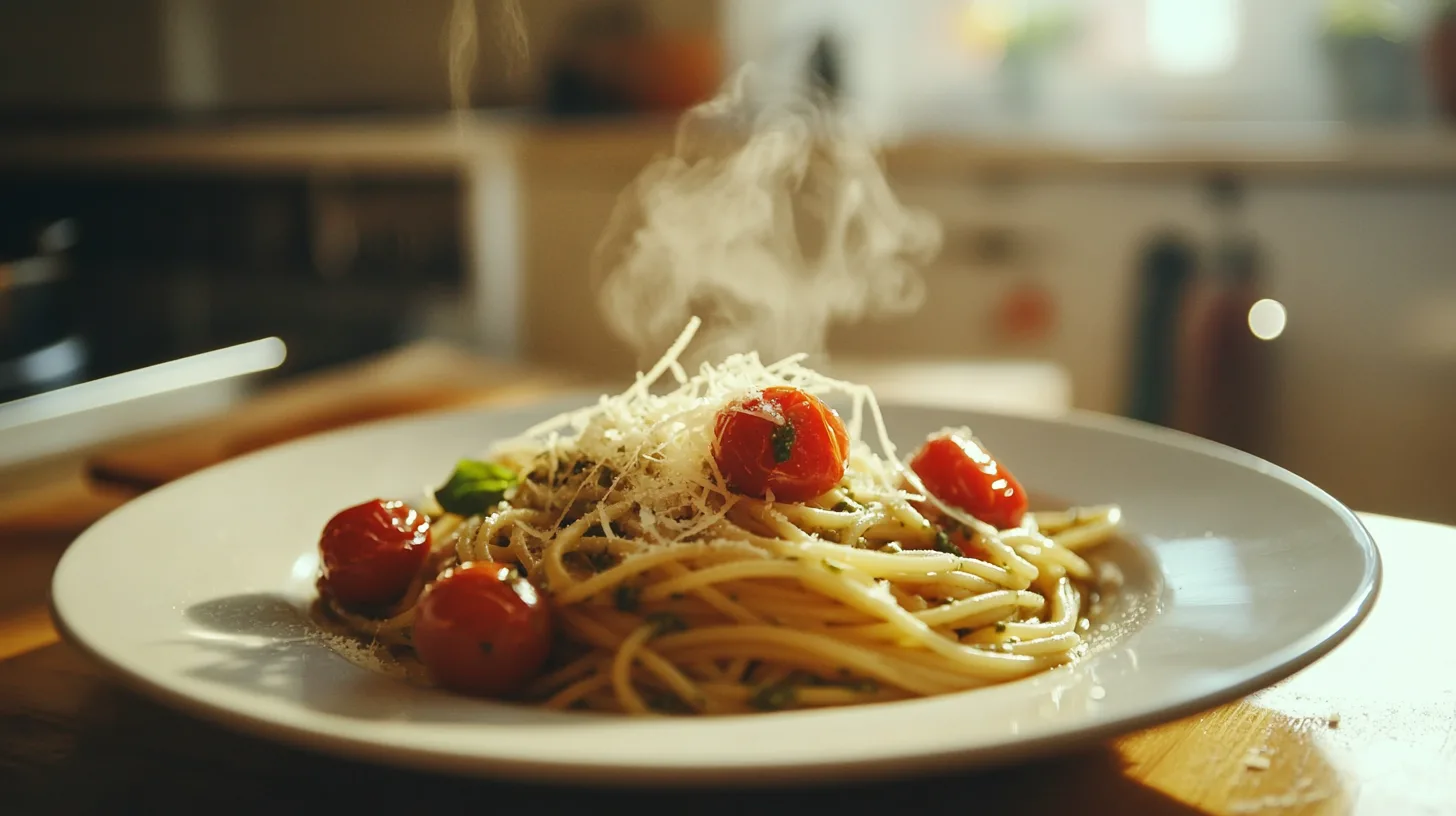Discover the Ultimate Lemon Pesto Pasta Recipe That Will Elevate Your Dinner Game
Ever found yourself craving a pasta dish that’s both refreshing and indulgent?
You whip up your usual spaghetti, but something’s missing, that vibrant kick to tantalize your taste buds.
Enter Lemon Pesto Pasta: the zesty, herbaceous solution to your dinner dilemmas. Let’s embark on a flavorful journey to master this delightful dish.
Unveiling Lemon Pesto Pasta
Lemon Pesto Pasta harmoniously blends the rich, nutty essence of traditional pesto with the bright, citrusy notes of lemon.
This fusion creates a dish that’s both comforting and invigorating, making it a favorite for many.
The Heart of the Dish Is The Key Ingredients and Their Roles

Crafting the perfect Lemon Pesto Pasta requires a balance of fresh ingredients, each contributing uniquely:
- Pasta: Serves as the foundation. While spaghetti is classic, penne or fusilli can also be used for varied texture.
- Fresh Basil Leaves: Provide the signature herbal aroma and vibrant green hue.
- Lemon Zest and Juice: Introduce a refreshing tang, elevating the overall flavor profile.
- Pine Nuts: Offer a subtle nuttiness and creamy texture when blended.
- Garlic Cloves: Add depth and a hint of pungency.
- Parmesan Cheese: Lends a salty, umami richness.The Blonde Chef
- Extra Virgin Olive Oil: Ensures a smooth, cohesive sauce.
- Salt and Freshly Ground Black Pepper: Enhance and balance the flavors.Food & Wine
Crafting the Perfect Lemon Pesto Pasta: Step-by-Step Guide

Cook the Pasta
In a large pot of boiling salted water, cook your chosen pasta until al dente. Reserve about a cup of the pasta water before draining.
Prepare the Lemon Pesto
In a food processor, combine fresh basil leaves, toasted pine nuts, garlic cloves, lemon zest, and grated Parmesan cheese.
Pulse until coarsely blended. While the processor runs, slowly drizzle in extra virgin olive oil until the mixture achieves a smooth consistency.
Season with salt and freshly ground black pepper to taste.
Combine and Serve
Return the drained pasta to the pot. Add the lemon pesto, tossing to coat evenly. If the sauce is too thick, gradually add the reserved pasta water until the desired consistency is reached. Serve immediately, garnished with additional Parmesan and a sprinkle of lemon zest if desired.
Nutritional Insights: Indulgence Meets Wellness
While Lemon Pesto Pasta offers a luxurious taste experience, it’s also nutritionally balanced.
A typical serving provides carbohydrates for energy, healthy fats from olive oil and pine nuts, and protein from Parmesan cheese.
The addition of lemon not only enhances flavor but also contributes vitamin C, supporting immune health.
Ingredient Alternatives And Personalizing Your Pasta

Adaptability is key in cooking. Here are some substitutions to cater to different preferences or pantry availability:
- Basil Alternatives: If fresh basil is scarce, consider using arugula or spinach for a different yet delightful twist.
- Nut Variations: Swap pine nuts with walnuts, almonds, or cashews for a unique flavor profile.
- Cheese Options: Parmesan can be replaced with Pecorino Romano or nutritional yeast for a dairy-free option.
Elevating the Dish Tips and Tricks
- Toasting Nuts: Lightly toasting nuts before blending intensifies their flavor, adding depth to the pesto.
- Balancing Acidity: Adjust the amount of lemon juice to find your preferred balance between tangy and savory.
- Consistency Control: Use reserved pasta water to adjust the sauce’s thickness, ensuring it clings perfectly to the pasta.
Pairing Suggestions With Complementing Flavors
Enhance your Lemon Pesto Pasta experience with these pairings:
- Protein Additions: Grilled chicken, shrimp, or scallops make excellent companions, adding protein and heartiness.
- Wine Pairing: A crisp Sauvignon Blanc or Pinot Grigio complements the dish’s citrus notes beautifully.
- Side Dishes: A simple arugula salad with a light vinaigrette or roasted asparagus aligns well with the pasta’s flavors.
Storing and Reheating And Savoring Leftovers
Store any leftovers in an airtight container in the refrigerator for up to two days. When reheating, add a splash of water or olive oil to maintain the sauce’s consistency and prevent dryness.
Frequently Asked Questions (FAQs)
Certainly! Lemon pesto pairs well with grilled vegetables, as a spread on sandwiches, or as a flavorful addition to soups.
Yes, prepare the pesto ahead and store it in the refrigerator for up to three days. Ensure it’s covered with a thin layer of olive oil to prevent oxidation.
Absolutely, Lemon Pesto Pasta is vegetarian-friendly. For a vegan version, substitute Parmesan with nutritional yeast.
Simply use gluten-free pasta to cater to gluten sensitivities.
A blender can work as an alternative. In a pinch, finely chopping the ingredients and mixing them manually can also suffice.
Freezing is possible. Portion the pesto into ice cube trays for easy, single-use servings.
Storing it with a layer of olive oil on top and minimizing air exposure helps maintain its vibrant green color.
Lemon Pesto Pasta Recipe Card
Print
Lemon Pesto Pasta Recipe
- Prep Time: 10 minutes
- Cook Time: 12 minutes
- Total Time: 22 minutes
- Yield: 4 servings 1x
- Category: Main Course, Dinner, Lunch
- Method: Boiling, Blending
- Cuisine: Italian
Description
This Lemon Pesto Pasta is a fresh, zesty twist on classic pesto that blends the brightness of lemon with the richness of toasted pine nuts, Parmesan, and sweet basil. What sets this version apart is the addition of blistered cherry tomatoes stirred in right at the end—adding a juicy, slightly caramelized pop of sweetness that balances the citrus and salt beautifully. It’s a dish that tastes like summer in a bowl, easy enough for a weeknight but fancy enough for company.
Equipment:
-
Large pot
-
Colander
-
Food processor
-
Skillet
-
Tongs or pasta fork
-
Measuring cups and spoons
-
Zester or microplane
-
Mixing bowl (optional)
Ingredients
- 12 oz spaghetti (or your favorite pasta)
- 2 cups fresh basil leaves, packed
- 1/4 cup pine nuts, lightly toasted
- 2 garlic cloves
- 1/2 cup freshly grated Parmesan cheese
- Zest of 2 lemons
- Juice of 1 lemon
- 1/2 cup extra virgin olive oil
- 1/2 tsp kosher salt (plus more for pasta water)
- Freshly ground black pepper, to taste
- 1 cup cherry tomatoes
- 1 tsp olive oil (for tomatoes)
- Optional garnish: extra Parmesan, lemon zest, fresh basil
- 12 oz spaghetti (or your favorite pasta)
- 2 cups fresh basil leaves, packed
- 1/4 cup pine nuts, lightly toasted
- 2 garlic cloves
- 1/2 cup freshly grated Parmesan cheese
- Zest of 2 lemons
- Juice of 1 lemon
- 1/2 cup extra virgin olive oil
- 1/2 tsp kosher salt (plus more for pasta water)
- Freshly ground black pepper, to taste
- 1 cup cherry tomatoes
- 1 tsp olive oil (for tomatoes)
- Optional garnish: extra Parmesan, lemon zest, fresh basil
Instructions
- Boil the Pasta:
Bring a large pot of salted water to a boil. Cook the spaghetti until al dente, according to package instructions. Reserve 1 cup of pasta water, then drain and set aside. - Blister the Tomatoes:
While the pasta cooks, heat 1 teaspoon of olive oil in a skillet over medium-high heat. Add the cherry tomatoes and cook, shaking the pan occasionally, until they blister and just begin to burst (about 5–6 minutes). Remove from heat and set aside. - Make the Lemon Pesto:
In a food processor, combine the basil, toasted pine nuts, garlic, Parmesan, lemon zest, and lemon juice. Pulse a few times to break everything down.
With the motor running, slowly drizzle in the olive oil until the mixture is smooth and creamy. Scrape down the sides and blend again. Season with salt and black pepper to taste. - Combine Pasta and Sauce:
In a large mixing bowl or back in the warm pasta pot, toss the cooked pasta with the lemon pesto. Add a little reserved pasta water at a time until the sauce coats the noodles evenly and clings nicely. - Add the Tomatoes:
Gently fold in the blistered cherry tomatoes for a sweet and juicy contrast. - Serve:
Plate the pasta and top with extra Parmesan, a sprinkle of lemon zest, and fresh basil if you like.
Notes
The addition of blistered cherry tomatoes is what really makes this version stand out. Most lemon pesto recipes rely solely on the sharpness of lemon and richness of cheese, but the tomatoes bring balance. Their natural sweetness deepens the flavor of the dish, while their juicy burst adds texture. You could even substitute sungold tomatoes for an even fruitier finish.
Nutrition
- Calories: 450 kcal
- Sugar: 3g
- Sodium: 220mg
- Fat: 20g
- Saturated Fat: 3g
- Carbohydrates: 55g
- Fiber: 5g
- Protein: 10g
- Cholesterol: 10mg
The Final Bite
If this Lemon Pesto Pasta hit the spot – and you’re hungry for more recipes like it – consider signing up for the Simply Delicious Newsletter.
It’s where I share fresh ideas straight from the line, quick wins, and flavor-forward dishes designed for real life.
I’m Ryan Yates – Executive Chef with 20 years in commercial kitchens, still cooking every day and sharing the kind of food I actually want to eat when I get home. Hope this one makes it into your regular rotation.
About the Author
Ryan Yates is a culinary expert with over 20 years of experience in commercial kitchens. As a working executive chef, he has a passion for creating delicious, accessible recipes that bring joy to home cooks everywhere. Ryan believes in the magic of simple ingredients and loves sharing his knowledge to help others find happiness in cooking.


